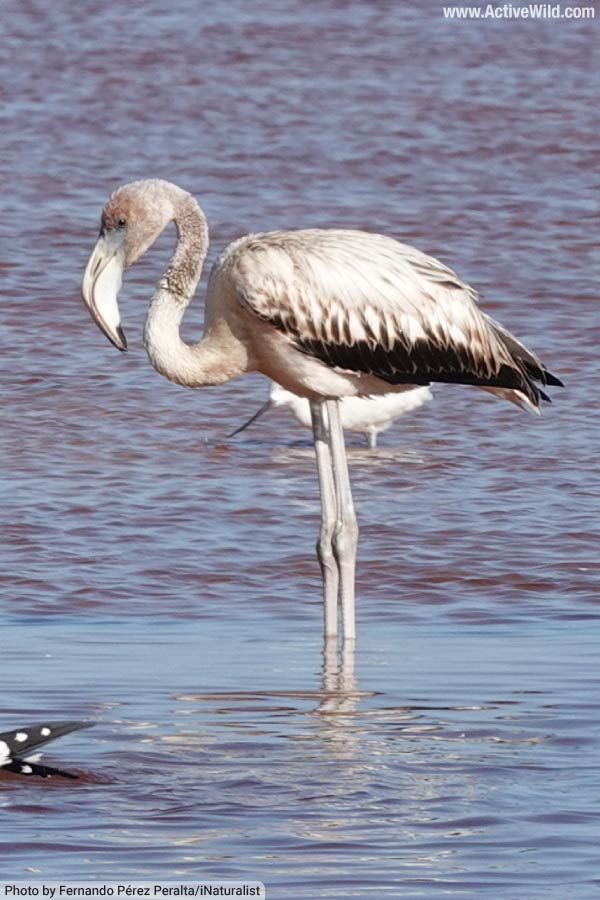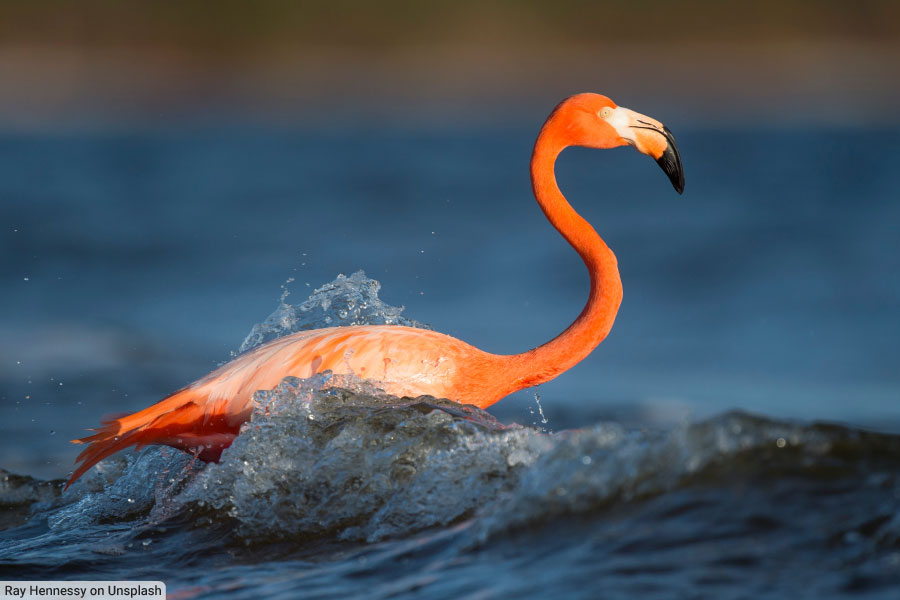The American flamingo is one of four flamingo species found in the Americas, and the only flamingo found in the USA, where it inhabits coastal and wetland habitats in Southern Florida.
Read on for a complete guide to this distinctive species…
What Is An American Flamingo?

The American flamingo (Phoenicopterus ruber) is one of six species of flamingo, wading birds known for their striking pink plumage, long neck and legs, curved beaks, and “upside-down” filter-feeding behavior.
Native to the Caribbean, parts of Central and South America and Southern Florida, the American flamingo is the only flamingo species naturally present in North America.
The species inhabits salty lagoons and shallow coastal waters, where it feeds primarily on algae, crustaceans, and other small organisms.
The American flamingo’s distinctive pink coloring is a result of its diet; the carotenoid pigments in the crustaceans and algae eaten by the bird are broken down and deposited in its feathers and skin.
A highly social species, the American flamingo lives in flocks that can contain thousands of individuals.

American Flamingo Stats
- Scientific Name: Phoenicopterus ruber
- Other Names: Caribbean Flamingo
- Order: Phoenicopteriformes
- Family: Phoenicopteridae
- Height: 1.1 to 1.5 meters (3.6 to 4.9 feet)
- Wingspan: 1.4 to 1.65 meters (4.6 to 5.4 feet)
- Weight: 2 to 3.6 kg (4.4 to 8 lb)
- Where found: Caribbean, parts of Central and South America, southern Florida
- IUCN conservation status (as of August 2023): Least Concern
Physical Description

The American flamingo is a tall, elegant bird with striking pink plumage that varies in intensity from pale rose to bright coral. Its long neck supports a proportionally small head with a downward-curving, pale bill that is pink at the base and black at the tip.
The bird’s slender legs are pink, and end in webbed feet. Its eyes are encased in a yellow ring.
The American flamingo’s black flight feathers are largely hidden when the bird is not in flight, but are clearly visible when the wings are open, appearing as a thick black band along the back edge of the wing.
(Flight feathers are the long, specialized feathers on the outer part of a bird's wing that provide lift and thrust.)
When in flight, the flamingo's legs trail behind the body, extending beyond the length of its tail.
American Flamingo Call
The call of the American flamingo is often described as a goose-like honking, which is resonant and can be quite loud.
Where Are American Flamingos Found?

The American flamingo predominantly occupies the Caribbean region, where it can be found in numerous islands and coastal areas. Countries such as the Bahamas, Cuba, and the Turks and Caicos Islands are among the species’ prime habitats.
The American flamingo also inhabits areas of Central America, especially along the northern coasts of the Yucatán Peninsula in Mexico and the coastal areas of Belize. In South America, the species’ range includes coastal regions of Colombia and Venezuela, parts of Brazil, and the Galápagos Islands.
Occasionally, especially during breeding season or due to disruptions in its primary habitats, the American flamingo might be spotted in the southernmost parts of Florida in the U.S., making it the only flamingo species found naturally in North America. The species is present in the Everglades and the Florida Keys.
Habitats preferred by the American flamingo include salty lagoons, mudflats, shallow coastal waters, and salt flats. As well as being rich in nutrients, these habitats also offer a relatively low threat from predators, and their saline or hyper-saline conditions reduce competition from other wading birds.
Food availability is a significant factor in the American flamingo’s choice of home; if there are insufficient resources, the flamingo will move to another area.
American Flamingo Diet & Feeding
The American flamingo is an omnivore that primarily feeds on algae, crustaceans (including brine shrimp), seeds, and other small aquatic organisms such as mollusks, fish, and insects.
Like all flamingos, the American flamingo’s beak is adapted for filter feeding. Lamellae (comb-like structures) present in the bill sieve tiny organisms out of the water. While feeding, the flamingo turns its head upside down in the water, moving it side to side to gather and filter food.
The carotenoid pigments found in many of the organisms eaten by the flamingo, particularly brine shrimp and blue-green algae, are responsible for giving the bird its distinctive pink hue.
American Flamingo Family And Related Species
The American flamingo is one of six flamingo species, and one of the four flamingos present in the Americas. Together, the six flamingos make up the family Phoenicopteridae, which is the only extant family of order Phoenicopteriformes.
The six flamingo species are listed below, together with their scientific name, range, and conservation status (as of August 2023).
- Greater Flamingo (Phoenicopterus roseus), Where Found: Africa, southern Europe, and parts of Asia, Conservation Status: Least Concern
- Lesser Flamingo (Phoeniconaias minor), Where Found: Sub-Saharan Africa and parts of India, Conservation Status: Near Threatened
- Chilean Flamingo (Phoenicopterus chilensis), Where Found: South America, especially in Chile, Argentina, and Bolivia, Conservation Status: Near Threatened
- James's Flamingo (Phoenicoparrus jamesi) (also known as the Puna Flamingo), Where Found: High-altitude regions of Peru, Chile, Bolivia, and Argentina, Conservation Status: Near Threatened
- Andean Flamingo (Phoenicoparrus andinus), Where Found: High-altitude regions of Peru, Chile, Bolivia, and Argentina, Conservation Status: Vulnerable
- American Flamingo (Phoenicopterus ruber) (also known as the Caribbean Flamingo), Where Found: Caribbean, parts of Central and South America, Southern Florida, Conservation Status: Least Concern
American Flamingo Life Cycle

Breeding is dependent on rainfall, which ensures that enough food is available for growing chicks.
The American flamingo is known for its elaborate courtship display, which consists of synchronized walking, head-turning and bobbing, wing opening, and preening, often performed by large numbers of individuals at the same time.
Mating takes place after the display has been performed to the satisfaction of both partners. The female American flamingo lays a single chalky white egg on a mud mound, which both parents take turns incubating. This incubation period typically lasts between 28 to 32 days.
The freshly-hatched chick has a straight bill, which will develop its characteristic curve as the bird matures. The chick is covered in a gray or white down and is entirely dependent on its parents for food.
The flamingo’s characteristic pink color only appears after two to three years as a result of a diet rich in carotenoids.
For the first few days after hatching, the chick is fed a nutrient-rich secretion known as "crop milk," which is produced by both parents. The milk contains fats, proteins, and other essential nutrients that help the bird grow rapidly during its initial days.
Once able to walk, the chick will leave the immediate care of its parents and join a creche, consisting of all of a flock’s young. Individuals continue to be fed by their parents.
As the chick grows, its down feathers begin to be replaced by juvenile feathers. At about 10 to 12 weeks, the infant flamingo is capable of flight.
The American flamingo reaches sexual maturity at around 3 to 5 years of age.
American Flamingo Lifespan
The lifespan of the American flamingo is up to 40 years, although, the average lifespan tends to be shorter due to predation and other natural threats.
Is The American Flamingo Endangered?
The American flamingo is not an endangered species; its current IUCN conservation status is Least Concern.
Discover More With Active Wild
You can find out more about birds on this page: Birds – The Ultimate Guide
Discover different types of birds on this page: Types of Birds
Visit our main animals page for links to animal information and a complete guide to the animal kingdom: Animals


